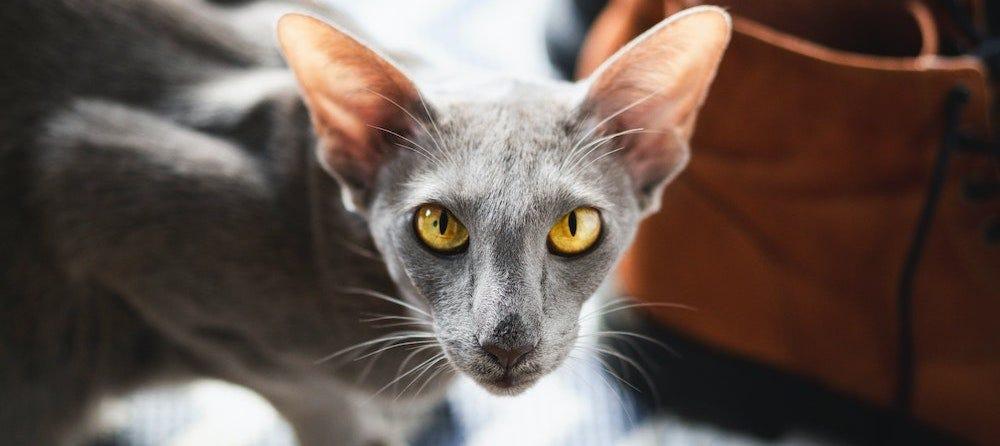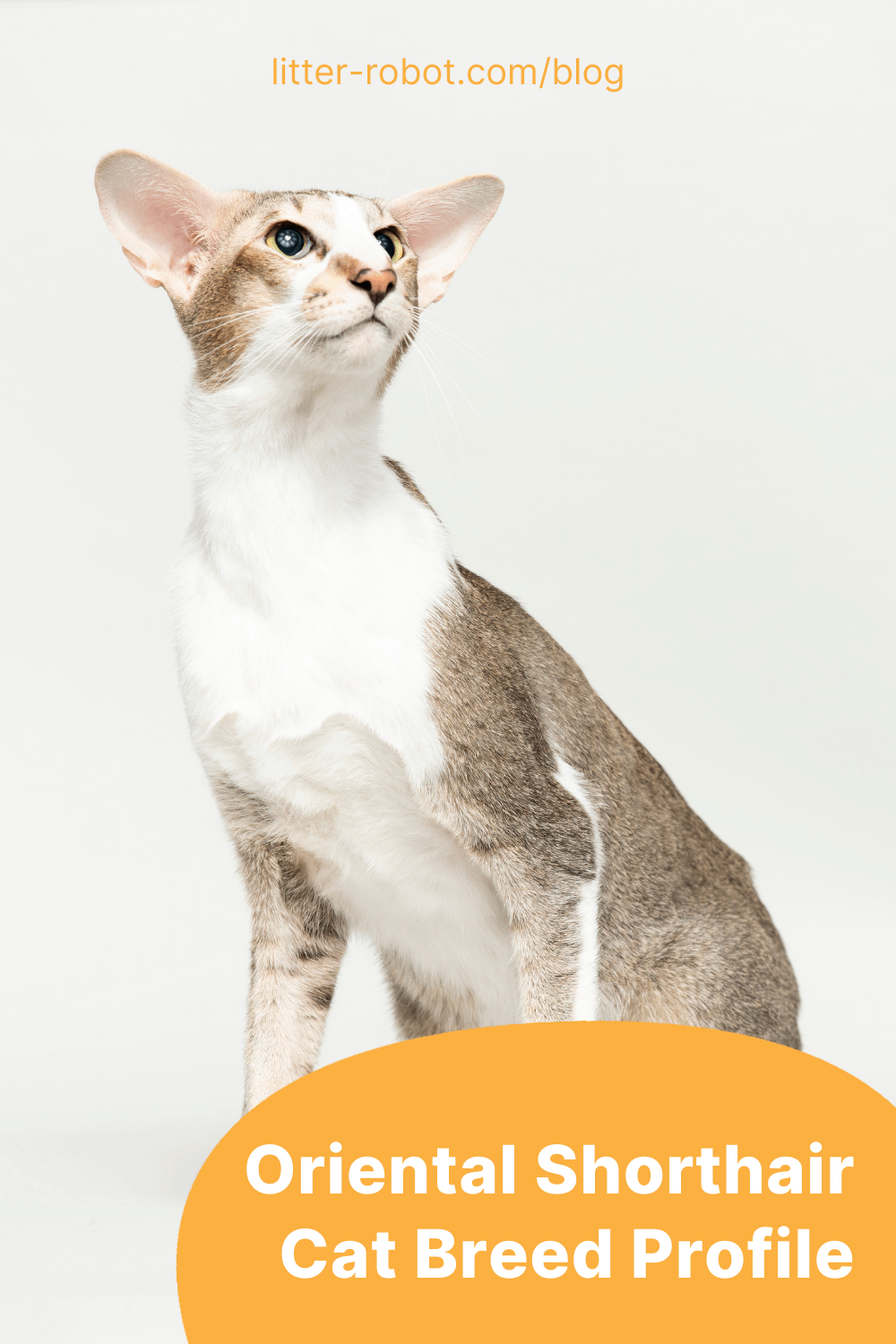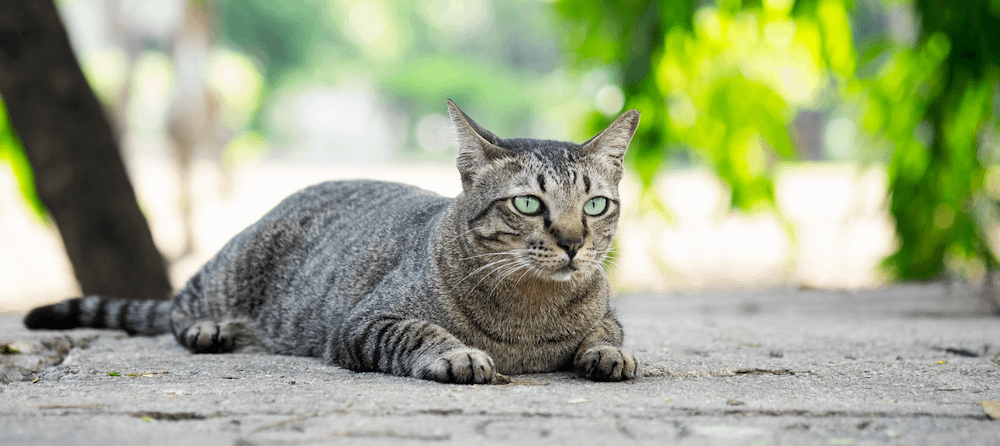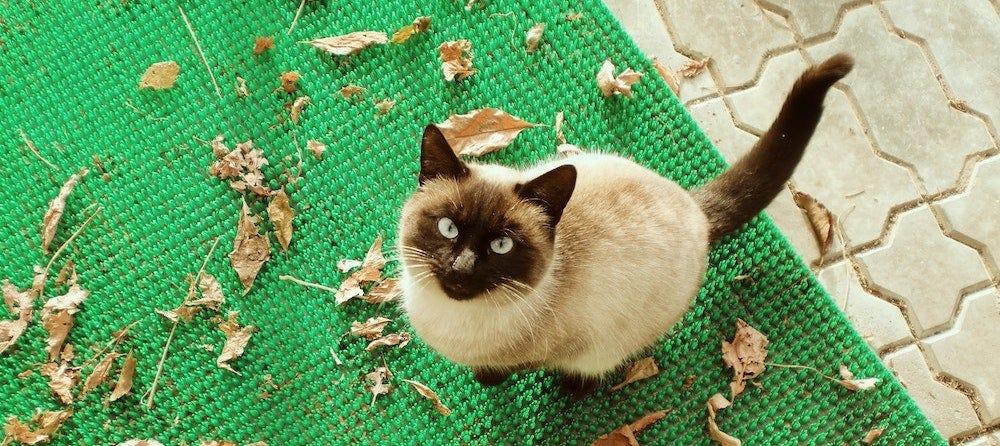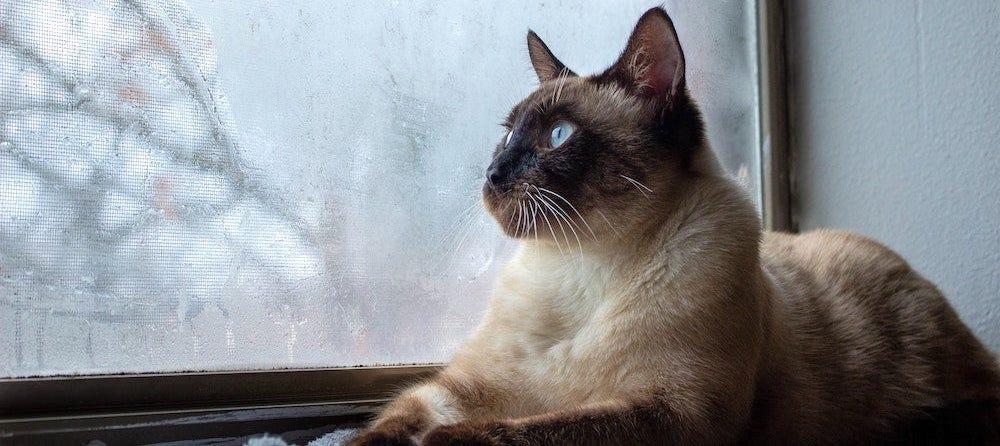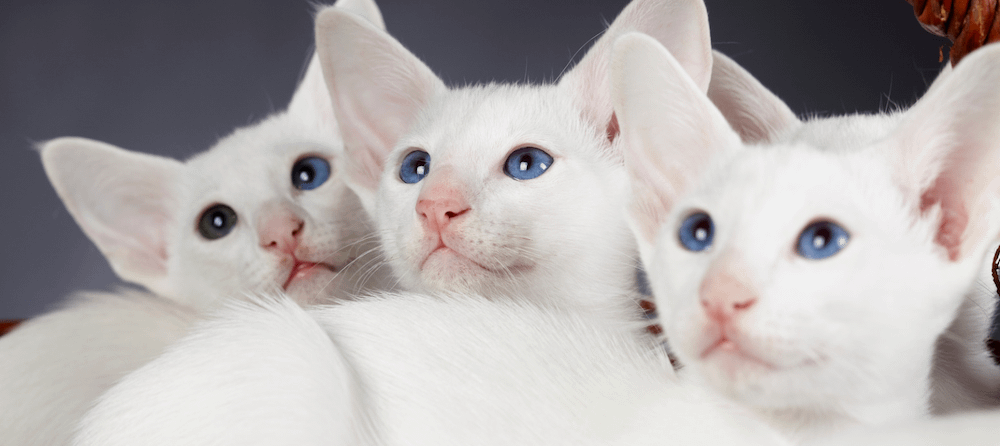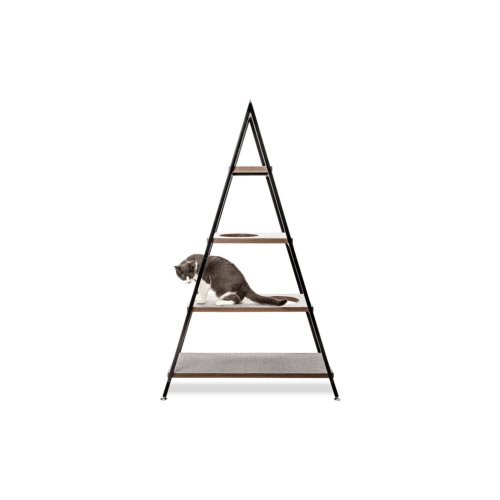You don’t just see an Oriental Shorthair and move along. You quite literally stop to stare at them: With their angled faces, expressive eyes, large ears, and slender frames, they make a statement.
At first, you might mistake them for a Siamese cat—and while there is history to explain how you got to this conclusion, the Oriental Shorthair is a separate breed prized for their loving nature.
These beautiful felines are often known as the “Rainbow Cat.” There are almost as many coat color variations as there are days in a year—up to 300 combinations—so you can never be sure of what you’ll see in a litter, thanks to their unique gene pool.
This cat breed is athletic and friendly. They want to spend time with their families, play fetch, and learn tricks to impress. (Make sure to give your natural entertainer a round of applause.) You will never be bored with an Oriental short hair cat around your home!
| Oriental Shorthair cat | ...at a glance |
|---|---|
| Personality | Entertaining, devoted, vocal |
| Life expectancy | 10-15 years |
| Weight | 5-12 lbs |
| Coat & colors | Short, sleek; 300+ color & pattern combos |
| Energy level | High |
| Affection level | High |
| Friendliness | High |
| Shedding level | Medium |
| Required grooming | Low |
Overview of the Oriental Shorthair cat

The Oriental Shorthair is a long and elegant cat breed. Though considered small to medium-sized, they may appear larger due to their long limbs and slender, tubular body. They have toned muscles that are frequently exercised due to their high energy levels and playfulness.
Weight
Oriental Shorthair cats range between 5 and 12 pounds, with males slightly on the heavier side. You might look at an Oriental Shorthair and think they are much bigger than they are, but that’s due to their height.
Length
Oriental Shorthairs can stand between 9 and 11 inches tall. Their long limbs award them additional height, giving the illusion that they are a large-sized cat breed. From the tip of their tails to their nose, they are usually around 18 inches long.
So, although they are tall and long cats, you might be surprised by their light weight when you pick them up!
Coat
The Oriental Shorthair’s coat is another feature that helps them stand out. They are called the “Rainbow Cat” because they can be born with up to 300 color combinations.
From lilac to ebony, from lavender to sable, from chocolate, white, blue, cream, red, brown, frost, platinum, fawn, chestnut, cinnamon, to champagne—this short hair cat has no rules when it comes to its coat’s appearance. Solid colors, parti-colors, bicolor with green or blue eyes… This cat is the cat’s meow!
Additional patterns that the Oriental Shorthair can display include calico, tabby, tortie, and more. If you want a cat that is going to be unique from their siblings, this is the one for you. You could guess what combination of color and pattern your cat’s litter would be, and you’d be unlikely to guess one correctly; there are just too many options!
Life expectancy
With proper care, nutrition, and exercise, your Oriental Shorthair can live a long and happy life. Their lifespan is typically between 10 and 15 years.
Your cat relies on you to give them the best quality care, and if you do, they can reward you with years of companionship.
History of the Oriental Shorthair
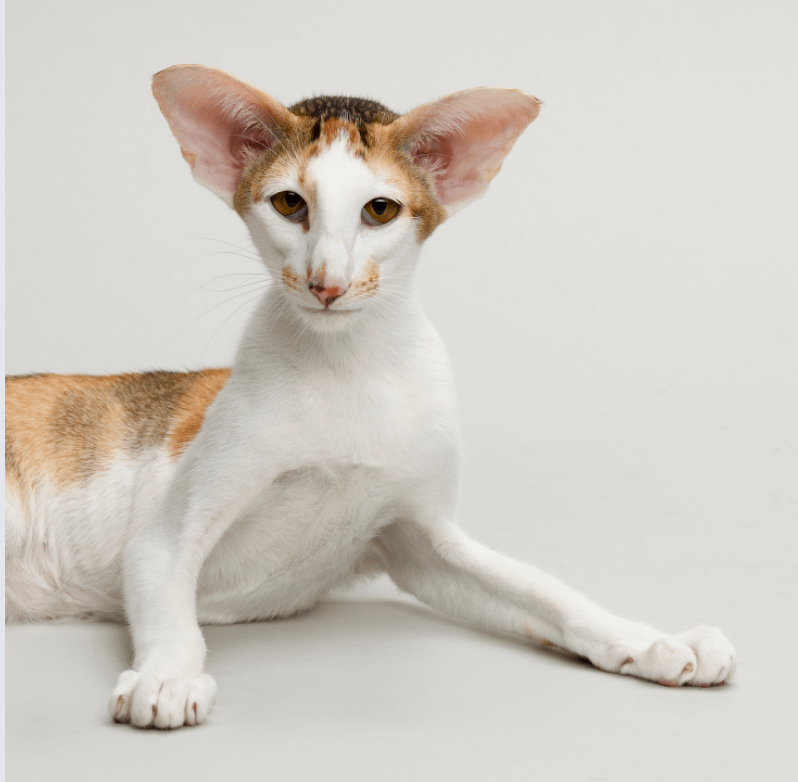
The Oriental Shorthair might remind you of the colorpoint Siamese cat, and there is a good explanation for that. Oriental Shorthair cats originated due to crossbreeding to revive the Siamese breed after World War II threatened to wipe out a variety of domestic cat breeds.
Breeders in Europe crossbred Siamese cats with British Shorthairs, Russian Blues, and Abyssinians, and then crossed those kittens back with Siamese cats. This resulted in kittens with pointed coats that became the backbone of the Siamese breed revival. Other variations of coats and colors set the foundation for Oriental Shorthairs.
When Siamese cats and Oriental Shorthairs were first separated, breeders wondered if all color and pattern combinations should be their own breeds. This idea was dropped when they realized just how many breeds that would be (about 300 too many!). Thus, the Oriental Shorthair became the main breed, with colors and patterns as variations of the breed.
Characteristics
Though these cats bring an almost intimidating presence to the room, you can rest assured they are anything but. Oriental Shorthair features have been described as extreme, including long, angular faces, large eyes, and flaring ears.
Their height makes them appear taller and thinner than they truly are. When given a blue-eyed inquisitive glance, you might feel as if they are staring into your soul.
And, well, they might be.
Personality
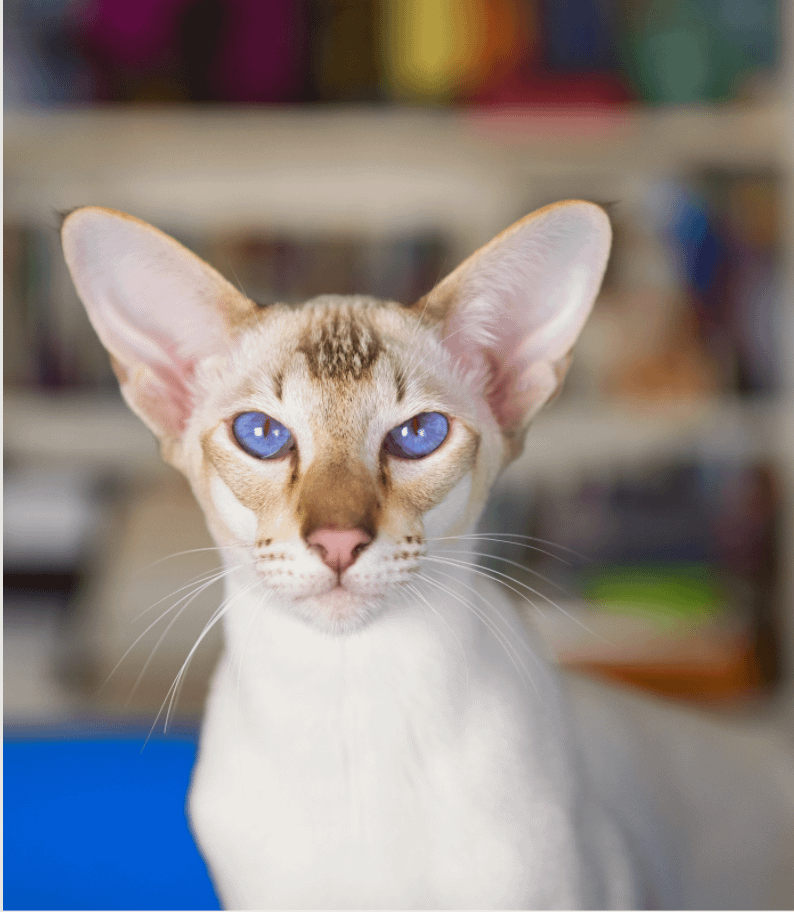
Even though these cats can look intimidating, they really are sweethearts that enjoy spending time with their families. Oriental Shorthairs even greet their pet parents at the door when they arrive home.
The Oriental Shorthair wants you to commit to them the way they commit to you. They will be a very loyal companion to you, as long as you return their loyalty and love.
You know those days where you just need to vent all your problems? So do Oriental Shorthairs. They are extraordinarily conversational and always have something to talk about with their family members.
If you are looking for a cat that will be quiet and solitary for long periods of time, that is not the Oriental Shorthair. They are vocal and spunky and want all of your attention.
The Oriental Shorthair can get lonely and depressed when left alone for too long. If you work a lot, getting your Oriental Shorthair a furry friend can really change how they feel during the day. They get along great with other cats and will even play with dogs.
Playtime and training
The Oriental Shorthair cat loves to learn new things. They will want you to play games with them, learn how to fetch, chase a mouse on a string, or even do simple tricks like sit and spin.
When taught from a young age, they can adapt well to being on a leash, allowing them to safely explore the outdoor world. These felines are curious, so they may get into things (aka, trouble) when they become bored.
To give your Oriental Shorthair the best life, they should have plenty of toys to keep them entertained. They can climb and jump gracefully, making your refrigerator and the top of your cabinets very enticing locations to perch on. (That’s why you should encourage them to use cat trees.)
Caring for an Oriental Shorthair

Oriental Shorthairs are typically a healthy and happy cat. To prevent health issues, you should take them to the veterinarian at least annually and feed them nutritional, portion-controlled meals.
Their coats are short and sleek, making grooming a bit easier than required by their cousins, the Oriental Longhairs. For the low-maintenance shorthair, you’ll want to brush their coat every week to keep shedding to a minimum, and provide occasional baths.
While they do a pretty good job of grooming themselves, you may need to stay on top of your Oriental Shorthair’s ears. Their ears are large and can trap wax very easily. You will want to check for wax build-up regularly. One method for cleaning cat ears is a few drops of water on a soft cotton ball. Keep in mind that using cotton swabs can be harmful to ears (for cats and people alike).
Oriental Shorthairs are particular about their bathroom space and, like most cats, prefer to use a clean litter box. And if you have one Oriental Shorthair, it’s likely that you have another (because being lonely is not fun).
In order to keep up with the litter box, try a self-cleaning litter box like Litter-Robot. This automatic litter box ensures your cat has a clean place to go every time, and you won’t have to worry about accidents around the house (or scooping constantly).
Possible health problems
The Oriental Shorthair, like Siamese, Abyssinian, and Balinese breeds, is more prone to developing renal amyloidosis. This is a serious condition that occurs when the abnormal protein amyloid forms deposits in otherwise healthy kidney tissue.
This build-up causes healthy kidney tissue to be replaced with protein, and the kidney begins to lose proper functioning. Sadly, you cannot do genetic testing to see if your Oriental Shorthair kitten was born with this.
Additionally, Oriental Shorthairs can develop progressive retinal atrophy, which is a gradual form of vision loss that isn’t fully present until between the ages of 3-5 years. You can test genetically for this, but there is no treatment for vision loss.
Adopting an Oriental Shorthair cat
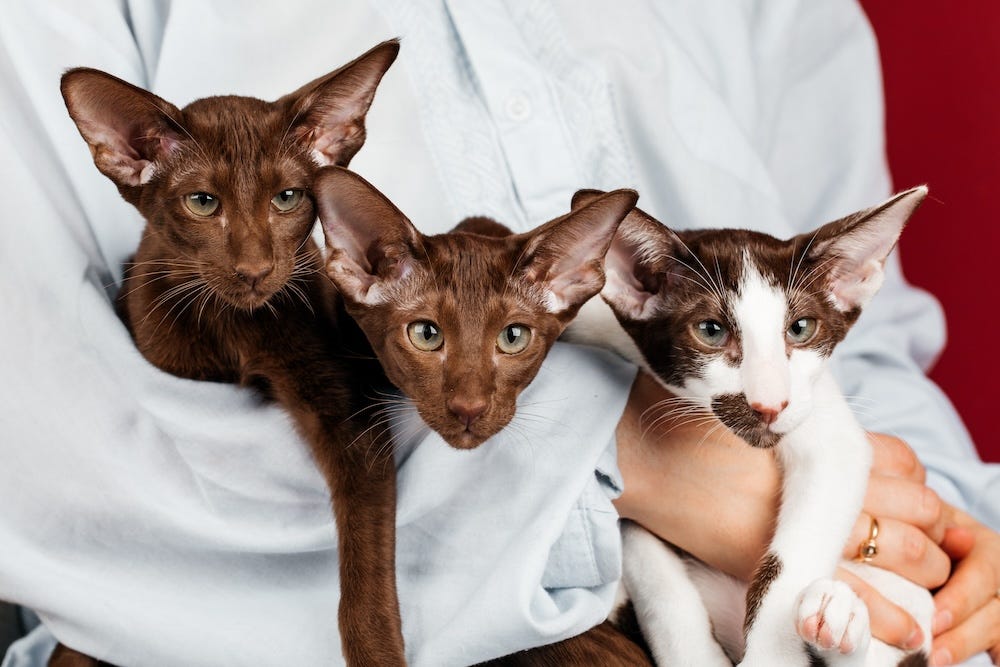
The Oriental Shorthair cat is a loving and intelligent breed that is determined to be your loyal companion. You should want to be this cat’s person just as much as they want to be your favorite feline.
And, if you adopt only one Oriental Shorthair, you’ll probably be ready to adopt another soon. You’ll love them immensely, and they’ll love you for giving them a friend!
Oriental Shorthair Price
On average, Oriental Shorthair price may range from $500 to $2,000 or more. The price of Oriental Shorthair kittens can be influenced by factors such as pedigree, breeder reputation, geographic location, and even coat color.
For example, fawn, ebony, or cinnamon-ticked tabby kittens are rare colors and are very sought after.
Sources:
- Shorthair Cat Breeds | Britannica
- Renal Amyloidosis | Cornell University College of Veterinary Medicine
- Progressive Retinal Atrophy in Cats | Oriental Cat Association
- Instructions For Ear Cleaning In Cats | VCA Animal Hospitals
Photo credits
- Manuel Keller via Unsplash
